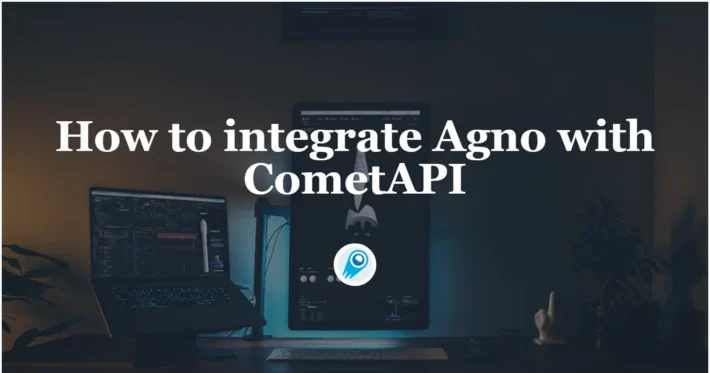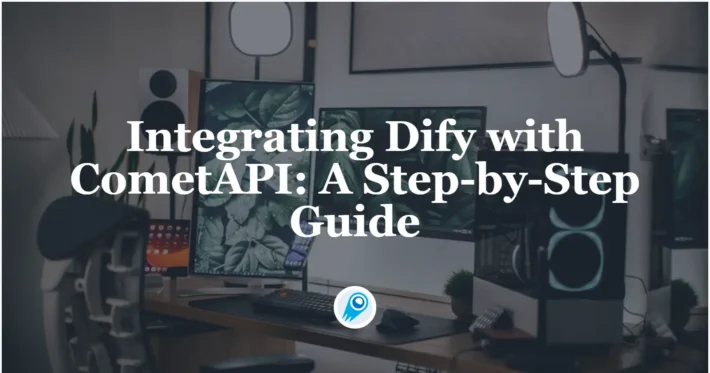How to integrate LlamaIndex with CometAPI

CometAPI provides a single, OpenAI-compatible gateway to many models (GPT-family, Anthropic/Claude, Google Gemini and more). LlamaIndex (the “data framework” for building retrieval-augmented LLM apps) now exposes a native CometAPI LLM integration — meaning you can **call any model via CometAPI from LlamaIndex.
LlamaIndex (the data-framework for building knowledge assistants) now officially supports CometAPI as an LLM backend. This guide shows why you’d pair them, how to set up the environment, step-by-step integration (with code), a concrete RAG use case, and tips to improve reliability, cost and observability. Examples follow the LlamaIndex docs and the CometAPI integration examples.
What is LlamaIndex and what are its key features?
LlamaIndex (formerly GPT-Index) is a data-abstraction and retrieval framework that connects large language models (LLMs) to your own data by ingesting documents, building indexes, and orchestrating retrieval + prompting workflows for RAG-style applications. Key features include document ingestion connectors (PDFs, web, databases), vector/keyword/graph indexes, flexible query engines, and an abstraction layer for swapping LLM providers. LlamaIndex is designed to let you “bring your own data” to any LLM and builds the plumbing for document chunking, embeddings, retrieval, and prompt orchestration.
What are the main features?
- Data connectors: ingest from files, databases, and many SaaS sources.
- Indexing primitives: vector store indexes, tree/graph indexes, and retrieval pipelines.
- Query engines: flexible query orchestration (rerankers, response synthesis, multi-step prompts).
- LLM adapters: pluggable LLM backends — OpenAI, Anthropic, Vertex, and now CometAPI among others.
- Observability & callbacks: hooks for tracing and monitoring LLM calls.
What is CometAPI and why use it with LlamaIndex?
What is CometAPI?
CometAPI is an API-gateway that exposes hundreds of third-party AI models (LLMs, image/video generators, and embeddings) behind a single, OpenAI-compatible REST interface. Instead of juggling a distinct SDK and key for each model vendor, you call CometAPI’s base URL and select the model name in the request body — for example gpt, claude, gemini, or various specialized embed/image engines. This “one API for 500+ models” approach speeds up experimentation and reduces operational overhead.
Why pair CometAPI with LlamaIndex?
LlamaIndex is a data framework that turns your documents into indices (vector and others) and uses an LLM for final answer synthesis. Because CometAPI speaks an OpenAI-style API, LlamaIndex can either:
- Use its built-in
CometAPILLM integration (recommended), or - Use the OpenAI/“OpenAI-compatible” LLM and embeddings adapters by pointing
api_baseto CometAPI.
LlamaIndex already provides a dedicated CometAPI LLM wrapper and examples — so the integration is intentionally straightforward.
What benefits does integration deliver?
- RAG + flexible model choice — LlamaIndex handles data retrieval and prompt synthesis; CometAPI lets you pick the LLM(s) you call without rearchitecting your pipeline.
- Cost/latency optimization — try cheaper or faster models for routine queries and higher-quality models for heavy reasoning.
- Vendor portability — swap model providers by only changing model names or small client config.
- Rapid experimentation — easily A/B models while keeping your indexing and retrieval pipeline constant.
What are the prerequisites and environment setup?
Accounts & keys
Sign up for CometAPI and get an API key from the CometAPI console: https://api.cometapi.com/console/token. (You’ll need this value to authenticate requests.)
Python and packages
- Python 3.9+ recommended.
- Jupyter Notebook or Python environment (Google Colab recommended for interactive testing).
- Packages to install:
llama-index(core) andllama-index-llms-cometapi(the CometAPI adapter / integration) - Optional: vector store libraries you plan to use (e.g.,
faiss-cpu,pinecone-client, etc.). LlamaIndex has official/vector store guides.
Environment variables
Common practice: set the CometAPI key as an env var (e.g. COMETAPI_KEY), or pass the key directly to the LlamaIndex CometAPI constructor. The LlamaIndex docs show both approaches — to avoid ambiguity and tests, passing api_key= explicitly to the constructor is safest.
How do you integrate LlamaIndex and CometAPI step-by-step?
The following step-by-step list covers the exact actions: create an account, install packages, set keys, configure LlamaIndex to use CometAPI.
1) How do I create a CometAPI account and get an API key?
- Visit CometAPI’s site and sign up for an account. (Their homepage and signup flow will direct you to the API console.)
- In the CometAPI console (the docs reference
https://api.cometapi.com/console/token), create or copy your API token. You’ll need this forCOMETAPI_API_KEY(see below).
2) How do I install LlamaIndex and the CometAPI integration?
Run these pip commands (recommended inside a virtual environment):
# core LlamaIndex
pip install llama-index
# CometAPI LLM integration for LlamaIndex
pip install llama-index-llms-cometapi
# optional: vectorstore (FAISS example)
pip install faiss-cpu
(If you're in a Jupyter/Colab environment you can prefix with `%pip`.)Notes:
- LlamaIndex uses namespaced integration packages to avoid shipping everything in core. The CometAPI LLM integration is provided as
llama-index-llms-cometapi.
3) How do I set the CometAPI key (environment variable)?
LlamaIndex’s CometAPI LLM class reads the API key from either a constructor parameter or an environment variable. The integration’s code expects the environment variable name COMETAPI_API_KEY (you can also pass the key directly to the class constructor). It also supports COMETAPI_API_BASE if you must override the API base URL.
Recommended (explicit) — pass the API key to the constructor. You can also set the env var COMETAPI_KEY if you prefer.
import os
# Option A: set env var (optional)
os.environ["COMETAPI_KEY"] = "sk-xxxx-your-key"
# Option B: pass the key explicitly (recommended for clarity)
api_key = os.getenv("COMETAPI_KEY", "sk-xxxx-your-key")Set it locally (Unix/macOS):
export COMETAPI_API_KEY="sk-<your-cometapi-key>"
# optional override:
export COMETAPI_API_BASE="https://api.cometapi.com"
On Windows (PowerShell):
$env:COMETAPI_API_KEY = "sk-<your-cometapi-key>"
4) Configure LlamaIndex to use CometAPI
Below is a minimal end-to-end example: ingest documents, build a vector index, and issue a query. This example uses the modern LlamaIndex API (Example A: ServiceContext + vector index); adapt names if you’re using an older/newer LlamaIndex release.
minimal RAG example using CometAPI as the LLM backend
from llama_index import SimpleDirectoryReader, VectorStoreIndex, ServiceContext
from llama_index.llms.cometapi import CometAPI
from llama_index.core.llms import ChatMessage
# 1) API key and LLM client
api_key = "sk-xxxx-your-key" # or read from env
llm = CometAPI(
api_key=api_key,
model="gpt-4o-mini", # pick a CometAPI-supported model
max_tokens=512,
context_window=4096,
)
# 2) Optional: wrap in ServiceContext (customize prompt settings, embedding model etc)
service_context = ServiceContext.from_defaults(llm=llm)
# 3) Load documents (assumes a ./data directory with files)
documents = SimpleDirectoryReader("data").load_data()
# 4) Build a vector index (FAISS, default vector store)
index = VectorStoreIndex.from_documents(documents, service_context=service_context)
# 5) Query the index
query_engine = index.as_query_engine()
resp = query_engine.query("Summarize the main points in the documents.")
print(resp)- Model names and available capabilities depend on CometAPI — check the CometAPI docs to pick the best model for your use case. The LlamaIndex Comet adapter supports chat and completion modes and streaming.
- If you want streaming responses you can call
llm.stream_chat([...])or use thestream_completevariant shown in the docs.
Note: depending on your LlamaIndex version, the exact API for
as_query_engineaccepting anllmargument may vary. If your version doesn’t acceptlServiceContexthere, see the LLM below. The CometAPI LLM is implemented asCometAPIinllama_index.llms.cometapi.
Example B — Minimal, direct use of CometAPI LLM (recommended for clarity)
import os
from llama_index.llms.cometapi import CometAPI
from llama_index import VectorStoreIndex, SimpleDirectoryReader
# ensure env var set, or pass api_key explicitly
os.environ["COMETAPI_API_KEY"] = "sk-<your-key>" # or set externally
api_key = os.getenv("COMETAPI_API_KEY")
llm = CometAPI(
api_key=api_key, # or pass None to use env var
model="gpt-4o-mini", # change model string as required
max_tokens=256,
context_window=4096,
)
# build a simple index (local documents)
documents = SimpleDirectoryReader("data/").load_data()
index = VectorStoreIndex.from_documents(documents)
# get a query engine that uses the default llm (you can often pass llm to the query method)
query_engine = index.as_query_engine(llm=llm) # some LlamaIndex versions accept llm here
response = query_engine.query("Summarize the key points of the corpus.")
print(response)How can I use CometAPI features from LlamaIndex? (advanced examples)
1) Call chat with ChatMessage List
Example:
# Initialize LLM
llm = CometLLM(
api_key=api_key,
max_tokens=256,
context_window=4096,
model="gpt-5-chat-latest",
)
# Chat call using ChatMessage
from llama_index.core.llms import ChatMessage
messages = [
ChatMessage(role="system", content="You are a helpful assistant"),
ChatMessage(role="user", content="Say 'Hi' only!"),
]
resp = llm.chat(messages)
print(resp)
# Use complete method
resp = llm.complete("Who is Kaiming He")
print(resp)Expected Output:
- Chat response: e.g.,
assistant: Hi - Completion response: e.g., a text description about Kaiming He, including information on ResNet.
This reproduces chat semantics (system / user / assistant roles) and often yields more controllable outputs. This sends a simple message and retrieves the model response. You can customize messages for more complex interactions.
Does CometAPI support streaming?
Yes — CometAPI supports streaming chat/completions and LlamaIndex exposes streaming methods on its LLM wrappers (stream_chat, stream_complete, streamable patterns). For real-time applications, use the stream_chat or stream_complete methods for streaming responses.. Example:
# Streaming chat
message = ChatMessage(role="user", content="Tell me what ResNet is")
resp = llm.stream_chat([message])
for r in resp:
print(r.delta, end="")
# Streaming completion
resp = llm.stream_complete("Tell me about Large Language Models")
for r in resp:
print(r.delta, end="")Expected Output: Streaming printed response content, e.g., an explanation of ResNet or an overview of large language models, appearing in chunks.
Explanation: stream_chat and stream_complete generate responses chunk by chunk, suitable for real-time output. If an error occurs, it will be displayed in the console.
This mirrors LlamaIndex examples for other OpenAI-compatible LLMs and works with Comet’s streaming endpoints. Handle backpressure and network errors with robust retry/timeout logic in production.
Switching models quickly
# try Claude from CometAPI
claude_llm = CometAPI(api_key=api_key, model="claude-3-7-sonnet-latest", max_tokens=300)
svc = ServiceContext.from_defaults(llm=claude_llm)
index = VectorStoreIndex.from_documents(documents, service_context=svc)
print(index.as_query_engine().query("Explain in one paragraph."))Because CometAPI normalizes endpoints, changing models is a constructor change only — no prompt pipeline rewrites required.
Tips and enhancement techniques
How to manage cost and tokens
- Use retrieval: send only the retrieved context, not the whole corpus.
- Experiment with smaller models for retrieval/summarization and larger models for final answer synthesis. CometAPI makes model swaps trivial.
Reliability and rate limiting
- Implement retry + backoff for transient errors.
- Respect CometAPI rate limits and implement a token budget per request. Track
max_tokensin the constructor.
Observability & debugging
- Use LlamaIndex callback manager to capture prompts, responses, and token use. Hook those logs into your monitoring pipeline. LlamaIndex docs cover observability patterns and integrations.
Caching and latency
- Cache LLM outputs for repeated queries or deterministic prompts (e.g., standard summaries).
- Consider using a small, faster model for the first pass and escalate to a higher-cost model only when needed.
Security
- Keep the CometAPI key in a secrets store (Vault / cloud secrets) — do not hard-code in code.
- If data is sensitive, ensure your chosen CometAPI plan or model meets compliance requirements.
Troubleshooting checklist
- Wrong env var: If LlamaIndex can’t find a key, pass
api_key=in theCometAPI()constructor to be explicit. (Docs show both env var and constructor options.) - Model unsupported: Confirm the model name with CometAPI’s model list — not every name exists on every account.
- Indexing errors: Ensure documents are parsed correctly (encoding, filetypes). Use
SimpleDirectoryReaderfor a fast test ingestion. - Version drift: LlamaIndex is actively evolving (ServiceContext → Settings migration). If an example fails, check the docs and migration guide for the version you have installed.
Getting Started
CometAPI is a unified API platform that aggregates over 500 AI models from leading providers—such as OpenAI’s GPT series, Google’s Gemini, Anthropic’s Claude, Midjourney, Suno, and more—into a single, developer-friendly interface. By offering consistent authentication, request formatting, and response handling, CometAPI dramatically simplifies the integration of AI capabilities into your applications. Whether you’re building chatbots, image generators, music composers, or data‐driven analytics pipelines, CometAPI lets you iterate faster, control costs, and remain vendor-agnostic—all while tapping into the latest breakthroughs across the AI ecosystem.
To begin, explore the model’s capabilities in the Playground and consult the LlamaIndex for detailed instructions. Before accessing, please make sure you have logged in to CometAPI and obtained the API key. CometAPI offer a price far lower than the official price to help you integrate.
Ready to Go?→ Sign up for CometAPI today !
FAQs
How do I debug latency or streaming breaks?
- Use a local network capture (or logging in your HTTP client) to inspect streaming frames.
- Try a simpler model to confirm that the network/SDK path, not the model itself, is the bottleneck.
Which model should I pick?
- Use smaller / cheaper chat models (e.g.,
gpt-4o-mini,o4-mini, or vendor-specific compact models) for high QPS or short answers. - Reserve large multimodal / chain-of-thought models for expensive reasoning tasks.
- Benchmark latency and cost: one of CometAPI’s benefits is switching models in the same code path — try multiple models quickly.
Which index & vector store should I choose?
- FAISS for on-prem / single-node speed.
- Pinecone / Weaviate for managed scale and multi-region availability (LlamaIndex supports many vector stores through integrations). Choose based on scale and latency.



